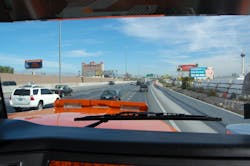(FYI: Steve Keppler with the Commercial Vehicle Safety Alliance put together an excellent speech on that very subject several years ago, which you can read here.)
Yet safety in trucking isn’t all about how to lower insurance costs, improve CSA metrics, etc. – lots of human lives are at stake here, those of truck drivers and all the motorists surrounding their big rigs on U.S. roadways every day.
(Highway safety is now an even more personal subject for me, for even as I write this, my oldest daughter is on the highway piloting a Chevy sedan in driving school – a situation famed actor Ralph Macchio touched on a few years back.)
That’s why the recent white paper jointly compiled by Fleetmatics Group PLC and the Fleet Safety Institute provides yet another reminder about the importance of highway safety. Consider these statistics highlighted in this report:
- According to the Federal Motor Carrier Safety Administration (FMCSA), there were almost 34,000 fatalities on the road in 2012 and approximately 4,000 of those were attributed to commercial vehicles.
- Of those 4,000 fatalities, the FMCSA found that, in about 30% of those cases, the commercial vehicle was at fault, ranking fatigue as the leading cause between 7% and 15% of the time.
- The National Safety Council (NSC) documents that the estimated cost of motor vehicle accidents is $22.3 billion each year
- Speeding is a factor in nearly 23% of all at-fault large truck crashes, according to the agency’s Large Truck Crash Causation Study (LTCCS) issued several years ago (findings that continue to be regularly analyzed to a degree.)
The white paper’s authors – Dale Willis, director of product marketing and business intelligence for Fleetmatics, and J. Kimo Ketner, VP of the Fleet Safety Institute – contend that technology can play a big role in helping commercial trucking fleets be safer.
“Aggressive and fatigued driving are just two of the key issues fleet operators must address,” noted Ketner. “Advanced technology that, for one, allows for driver-centric initiatives, can be integral to reigning in aggressive driving habits and also help efficiently and cost effectively address new hours of service (HOS) regulations designed to combat fatigued driving.”
Willis said that some of the advantages to using various technology tools to monitor and enhance fleet safety include: reducing the frequency with which drivers get lost in unfamiliar areas; signaling the unauthorized use of vehicles; aiding in the recovery of stolen vehicles and equipment; allowing for quicker emergency response; reducing vehicle maintenance costs; and decreasing payroll hours.“All of these things combined provide peace of mind to business owners and protect the bottom line,” he emphasized.
[As an aside, veteran truck driver Ralph Garcia provided one of the most clear-cut examples of how new technology – in his case roll stability control – saved his life and that of a fellow motorist.]
“But beyond the many aforementioned advantages of making fleet safety a priority, it is also the law for many businesses. The need to adhere to it has never been more vital, as the trucking HOS debate continues to take shape and an escalating number of sleep-deprivation and other non-safety- regulated accidents occur,” Willis stressed.
“Fleet safety programs must be implemented by every fleet-based business and should be emphasized as an essential company value, rather than a nice-to-have business feature,” he added. “Implementing safety programs can be seamless with the use of fleet management technology, which ensures a smooth rollout and an overall healthier organization.”
Something to keep in mind as the issue of how trucks impact highway safety will never – and should never, for that matter – go away.





